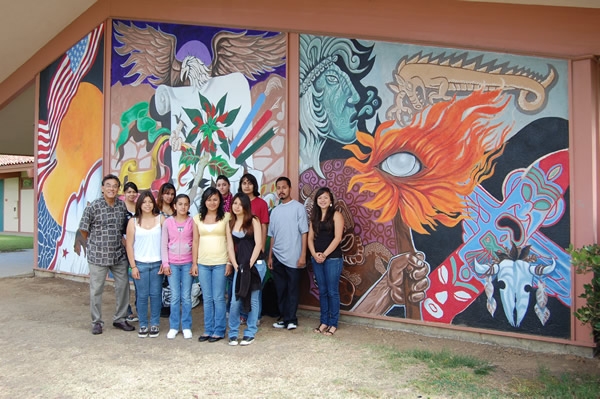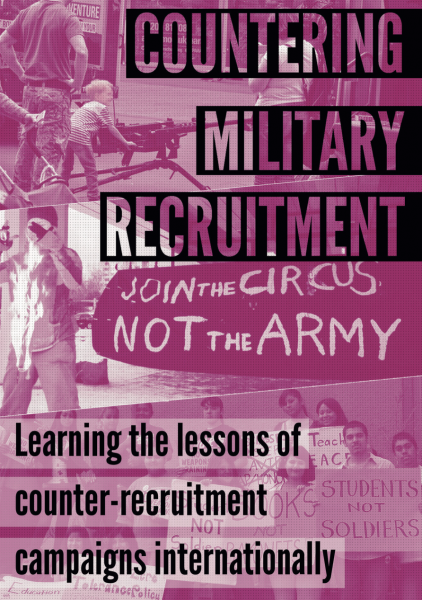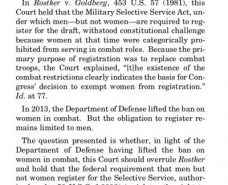Education Action: Reining in Military Recruiting

by Seth Kershner
In 2012, Kate Connell—a photographer with two children in the Santa Barbara public schools—learned that her son’s freshman seminar had a Marine recruiter as a guest speaker. Her son had challenged the recruiter, saying he didn’t like the way the U.S. military was always bombing other countries. At first, Connell thought, “Oh, it’s great you spoke up for yourself and spoke up for peace.”
Her second reaction was: “Oh, my gosh! The Marines were in his freshman class!”
Connell had a long, but dormant, history as an anti-war activist. When the Gulf War started in 1991, she was living in New York City, and she volunteered with the War Resisters League (WRL). Her main job with WRL was helping active-duty military file for conscientious objector status. Later, she relocated to Austin, Texas, where whe worked with Sustainable Options for Youth, visiting local high schools to stimulate discussions with students about “military myths.”
The shock she felt about the Marines targeting her 14-year-old and his classmates spurred her into resuming the activism she had left behind in Austin. The following summer, Connell started campaigning for stronger military recruiter access policies in the 14,000-student school district.
Although Connell was shocked that a recruiter could hold forth on military careers in a room of 9th graders, the practice is common. In 2011 a high-ranking officer in the U.S. Army Recruiting Command observed that recruiters across the country were increasingly relying on “guest teaching” opportunities in classrooms. According to U.S. Air Force recruiting data obtained through the Freedom of Information Act (FOIA), classroom presentations to 9th and 10th graders in Connecticut high schools end with the distribution of “lead cards” for students to fill out with their contact information.
The new Every Student Succeeds Act (see p. 18), which just replaced No Child Left Behind, continues the requirement that high schools receiving federal funding give military recruiters the same access to students as recruiters for colleges. But, according to David Cortright, director of policy studies at the Kroc Institute for International Peace at the University of Notre Dame, the Pentagon spends more than $1.4 billion per year on recruiting. So military recruiters can afford to make far more visits. At some schools, military careers overshadow the other options being presented to students. Connell says that by early 2012, when the Marine recruiter visited her son’s classroom, military recruiters were visiting Santa Barbara high schools on a monthly basis, always bringing along “gifts” for any student signing a lead card. Of most concern to Connell is the rosy picture of soldiering that they present. “Their job is to sell the military,” Connell says, “and people who sell things have to bend the truth.” When recruiters operate in a school setting, “they’re bending the truth with very vulnerable clientele.”
This seems especially true when it comes to the messy realities of military service. Two researchers who surveyed Texas high school students in 2010 found that, among those who reported contact with military recruiters in their schools, 86 percent were never told about the risks of serving in the armed forces. In a 2013 study, a UCLA researcher observed a classroom presentation by Army recruiters in which they suggested that soldiers can choose whether or not to serve in war zones. In reality, soldiers have no choice in the matter.
Connell believes that the military should not be in schools at all. However, she concedes that, for the time being at least, activists must adjust to the legislative reality. “If they are going to be in schools, they shouldn’t have easy access. They should be regulated and the number of their visits limited.”
Organizing for Restraints
“Most people without students in middle or high school aren’t even aware of this,” Connell says. “Counter-recruiters are engaged in a lonely kind of activism.”
 So, when Connell decided to push for a more stringent recruiter access policy, she drew on her relationships in the community. As a parent, she was active in her PTA. Past coalition work against gun violence had helped cement a relationship with several school board members. As a member of the Santa Barbara Friends Meeting, she got to know members of the national organization Veterans for Peace.
So, when Connell decided to push for a more stringent recruiter access policy, she drew on her relationships in the community. As a parent, she was active in her PTA. Past coalition work against gun violence had helped cement a relationship with several school board members. As a member of the Santa Barbara Friends Meeting, she got to know members of the national organization Veterans for Peace.
Connell met with an assistant superintendent during the summer of 2012 to discuss the district’s recruiter access policy. In response to her outreach efforts, Santa Barbara school board members decided to implement a protocol for the upcoming school year that set limits on the maximum number of visits by recruiters and curtailed their ability to actively solicit student information. However, since there was no enforcement mechanism, Connell knew the struggle could not stop there.
To better educate her community, she helped organize a public forum on military recruiting—attended by parents, military veterans, school board members, and even a local Marine recruiter. One outcome of the forum was a draft of a more detailed recruiter access policy. Together with Michael Cervantes, a counter-recruitment activist and member of Veterans for Peace, Connell continued pushing for the more detailed policy throughout the year. Then, last October, it passed by a unanimous vote of the board. The new access policy:
Limits the number of times recruiters can visit a particular school (twice a year from each agency/organization). Before the policy, it was a free-for-all, and Marine recruiters visited every month.
Prohibits recruiters from actively soliciting student information: “Recruiters visiting schools shall not at any time collect contact information directly from students or require it as a condition to participate in an activity or receive an award or gift.”
Policy Is Just the First Step
But the Santa Barbara activists still need an effective way to monitor compliance with the new recruiter policy. According to a 2013 planning document, also obtained through FOIA, the Navy’s L.A. recruiting district (which includes Santa Barbara County) has been engaged in “continued efforts” at “persuading most educators to relax restrictive school access” policies.
As a counterpoint, Connell says: “I would like Veterans for Peace to take a more active role, maybe by setting up literature tables in schools and keeping an eye on the military. Peace people don’t have resources comparable to the U.S. Department of Defense. For counter-recruiters to successfully get the military out of schools, we need a long-range plan.” For the Santa Barbara activists, the next step is trying to replicate their success in northern Santa Barbara County, where schools have a “heavier military footprint” due to the proximity of Vandenberg Air Force Base.
Three years into the campaign, Connell explains what keeps her going: “The military has just become so regular and acceptable—that’s the dangerous part of all this. If I can make it so it’s not perceived as normal that the military comes to campus every month, then I’ve been a success.”
Source: http://nnomy.org
###
Countering Military Recruitment

WRI's new booklet, Countering Military Recruitment: Learning the lessons of counter-recruitment campaigns internationally, is out now. The booklet includes examples of campaigning against youth militarisation across different countries with the contribution of grassroot activists.
You can order a paperback version here.








